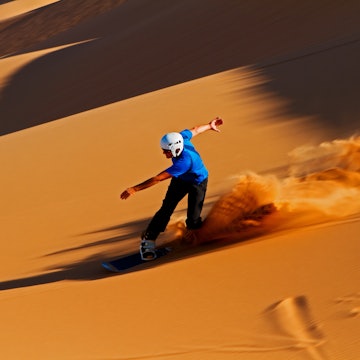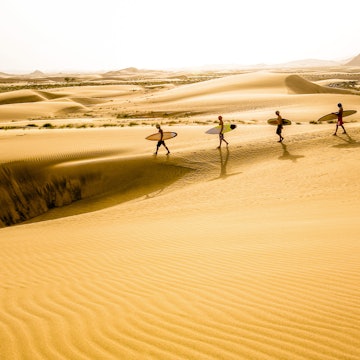
Namibia's best beaches for a sensational seaside experience

Sep 5, 2022 • 5 min read

Namibia's beaches offer everything from shipwreck encounters to surfing © Siempreverde22 / Getty Images
With nearly 1000 miles of coastline, Namibia offers some of the world's most unique and sensational seaside experiences. From shipwreck scouting and dune surfing to fishing for sharks, Namibia's wild shores offer thrills aplenty for adventurous travelers.
The image of a beach vacation for most travelers involves azure seas and relaxing while sipping cocktails under a beach umbrella. This dreamy scene couldn't be further from the reality of Namibia’s beaches. While you can find spots to relax and unwind, most visitors come to experience dramatic landscapes and adventure activities.
Namibia is one of the only places in the world where the desert comes right to the ocean's edge. As a result, temperatures shift constantly, and all four seasons can be experienced in a single day, from fog and mist to sunshine and cool coastal breezes to hot desert winds.
Flowing up from the Antarctic, the Benguela Current carries frigid waters with strong currents, so Namibia's beaches are not ideal for swimming, but the contrast of desert and water is certainly a sight to behold. Here's a guide to Namibia's best beach experiences.

1. Get an adrenaline rush in Swakopmund
Ranked as the best beach resort town in Namibia, Swakopmund offers tourist amenities, comfortable accommodations, ocean-view restaurants and stunning beaches. Located 352km (219 miles) west of the capital city of Windhoek, this popular town has also become known as Namibia's adventure capital, offering everything from sandboarding and skydiving to surfing on Atlantic swells.
The surrounding dunes, which plummet right into the sea, attract hardcore adventurers on outdoor tours. Swakopmund Fat Bike Tours offers tours on electric fat tire bikes, plus rentals for experienced riders. You can ride up, down and across the crimson dunes on these specially designed cycles, or cruise along the surf at the water's edge at sunset.
Tommy's Tours & Safaris offers a unique Living Desert Tour where expert guides take you on a 4WD expedition in search of rare, tiny desert creatures. The Swakopmund Skydiving Club allows you to take in the dramatic coastline from above on a tandem jump from 10,000ft. However, the extreme sport that has taken Swakopmund by storm in recent years is sand surfing or sandboarding; numerous tour operators in the area can arrange an afternoon riding the dunes of the world's oldest desert, the Namib.
Planning tip: Planes, trains and buses connect Windhoek and Swakopmund. Overnight trains are scenic but slow; traveling by road, privately-run shuttle buses are faster and more frequent than regular buses.

2. Spot shipwrecks on the Skeleton Coast
Travelers who visit this desolate stretch of coastline in northern Namibia come for the shipwrecks. Portuguese sailors once referred to the Skeleton Coast as the Gates of Hell because of its disorienting coastal fog and churning waves, which caused countless ships to run aground.
Most of these wrecks have been ravaged by the ocean and sand, but the “bones” of wrecks dating from the early 1500s and later stand testament to the fantastic power of Mother Nature. Road markers and GPS coordinates make these wrecks easy to find, and you can often walk right up to them, depending on the weather conditions and tides.
Skeleton Coast National Park is open between sunrise and sunset but it offers limited amenities. The only accommodations along this span of coastline – Shipwreck Lodge and Terrace Bay Resort – are 113km (70 miles) apart. A single salt road travels in and out of the park, with iconic skull and crossbones signs posted at the entrance gate.
Planning Tip: Most visitors come to the Skeleton Coast on tours or self-drive 4WD safaris. If you come under your own steam, plan carefully, bring plenty of supplies (including enough water, food and fuel) and prepare to be awestruck.
3. Go fishing at Henties Bay
Located 89km (55 miles) south of the Skeleton Coast, Henties Bay is a small resort town with a rustic, peaceful vibe. The waters here are protected by the bay and teem with fish; anglers dot the shoreline while beachgoers walk, picnic and sunbathe on the flat, sandy beach. The town is raised up from the beach on a dune that backs onto the shoreline, giving everyone a view of the Atlantic Ocean. The only drawback is that you'll need to climb back uphill to get to your hotel.
Fishing gear and bait are readily available in town, with the option to fish right from the beach or venture into deeper water on a boat fishing tour. Shark fishing is a popular activity in the bay thanks to the abundant plankton found offshore, which attracts many prey species.

4. Feast on fresh seafood at Walvis Bay
Just north of the Tropic of Cancer is the port town of Walvis Bay. This natural, deep-water harbor is Namibia's largest commercial port, and the waters of this natural lagoon are nutrient-rich, attracting seals, sea lions, flamingos, dolphins, fish and whales.
The lagoon side of town features a 3km-long paved esplanade lined with curio shops and local restaurants serving delicious local seafood. Don't miss the chance to try Walvis Bay's bivalves; locally farmed oysters have become synonymous with the bay. There is no other ocean current quite like the Benguela – the ocean's richest source of phytoplankton and oxygenated water – and it makes these oysters arguably the best in the world.
Planning tip: When it comes to seafood, Anchors @ the Jetty and Dockside Seafood & Grill are the most famous restaurants in Walvis Bay, with menus that reflect the diversity and richness of the waters at your feet.
5. Sandwich Harbor is best for birding and exploring wetlands
Accessible only on a guided tour from Walvis Bay, Sandwich Harbor is a breathtaking natural wonder on Namibia’s Atlantic coast. This 3km-wide tidal lagoon is surrounded by sand and reeds, providing a home for some 200,000 birds, including lesser and greater flamingos, terns, cormorants and great white pelicans. It's a protected marine sanctuary and a significant wetlands wilderness site.
Based in Walvis Bay, Sandwich Harbour 4x4 offers day and half-day tours to the lagoon. The drive takes you up and over the dunes, with magnificent views of the Atlantic Ocean, the bay, the lagoon and nearby pink salt pans. Once you reach the lagoon, your guide will walk you closer to the water to see the extraordinary abundance of birdlife up close. It's a paradise for photographers and birders.
On your way back across the dunes, you're likely to see other desert-adapted wildlife. There are regular sightings of ostrich, oryx, springbok and black-backed jackals, alongside varied reptiles, including web-footed geckos and the elusive sidewinder snake.













